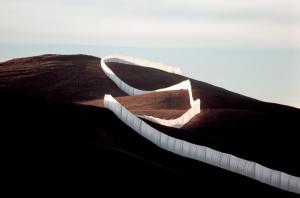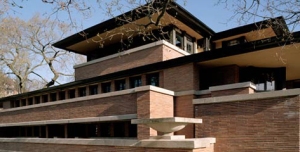For Thursday’s class, we went to the Atlanta Contemporary Art Center (http://thecontemporary.org/) to talk with Sarah Emerson (http://www.sarahemerson.com/). At the Contemporary, we saw Exquisite Exhibit: Parlour Games from the Studio Artist Program, an exhibition of collaborative works by artists who are either currently part of the Contemporary’s Studio Artist Program (including Ms. Emerson) or have been part of it in the past (http://thecontemporary.org/exhibitions/exquisite-exhibit-parlour-games-from-the-studio-artist-program/). Seeing an exhibition that involved the work of so many artists was helpful in thinking about the exhibition that I am planning for the collection/curation project, since my exhibition is likely to involve a variety of types of work from different artists and architects. We also saw Ms. Emerson’s studio. She talked about how her work involves breaking apart the landscape, including removing the horizon line, and putting it back together visually. She became interested in landscapes as a subject because she moved around a lot as a child and was always searching for a connection to any particular place. I asked Ms. Emerson about how having a studio at the Contemporary is similar to or different from other studio environments she has worked in before. She explained that it is nice to be connected with the institution, since many opportunities like Exquisite Exhibit come as a result of that. She likes that she is able to be around other artists, while also being able to have privacy and control of her personal space. She also enjoys having room to create large works. However, she also said that there are ways to innovate and make work in any type of studio environment. I also asked Ms. Emerson to explain more about the rhinestones that I noticed as I looked at her work. She explained that the rhinestones were included to give an “artificial pop” to the otherwise natural landscape. They also catch the light and draw the viewer’s eye to certain areas. In her most recent works, Ms. Emerson is trying to accomplish this with color, rather than with the rhinestones.

Sarah Emerson, Sweet Heebeegeebees. Acrylic and rhinestones on canvas, 36 x 36 inches.
image source: http://www.sarahemerson.com/
This is the painting on which I first noticed the rhinestones that I asked Ms. Emerson about. They can be seen on the tower of stones at the left of the canvas.
Seeing the collaborative exhibition and hearing Ms. Emerson talk about the importance of connecting with other artists reminds me of other fieldtrips, where we have discussed the importance of connecting to others in the arts community. In Donna’s questions about The Art Life, she points out the statement by Douglas Gordon that “Art is only an excuse for a conversation.”[1] This reminds me of the exhibition of collaborative works at the Contemporary because the artists in the exhibition seem to enter a dialogue through their art. Working together involves the give-and-take of conversation. Ideas discovered during the process of collaboration might continue to be influential after the end of the project. Thus, Gordon means that art is a method of making connections and sharing ideas that often continue into the future.
[1]Douglas Gordon quoted in Stuart Horodner, ed., The Art Life: On Creativity and Career (Atlanta, GA : New York,NY: Atlanta Contemporary Art Center ; Distributed by D.A.P./Distributed Art Publishers, 2012), 115.






